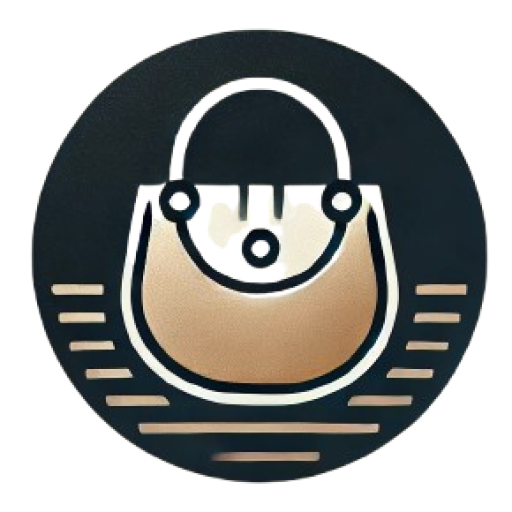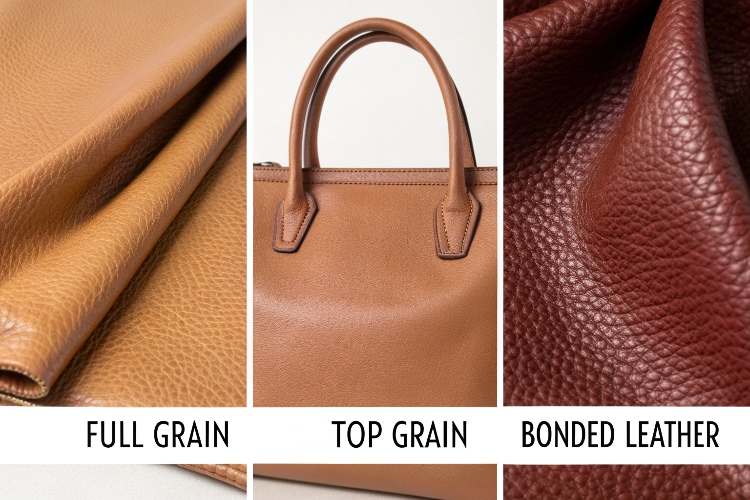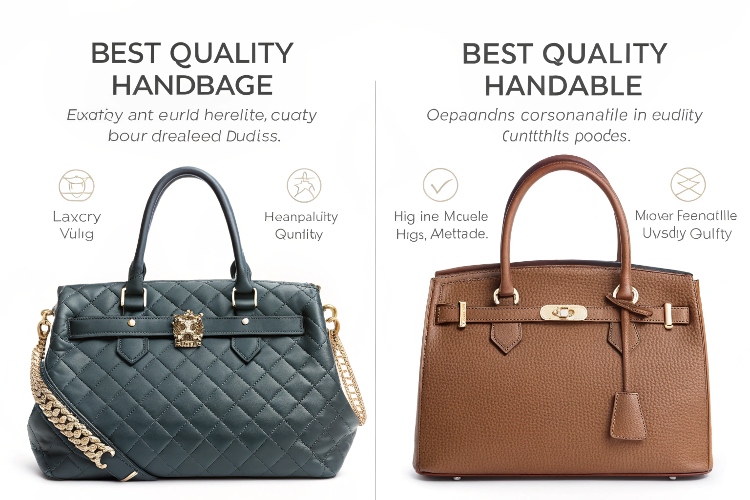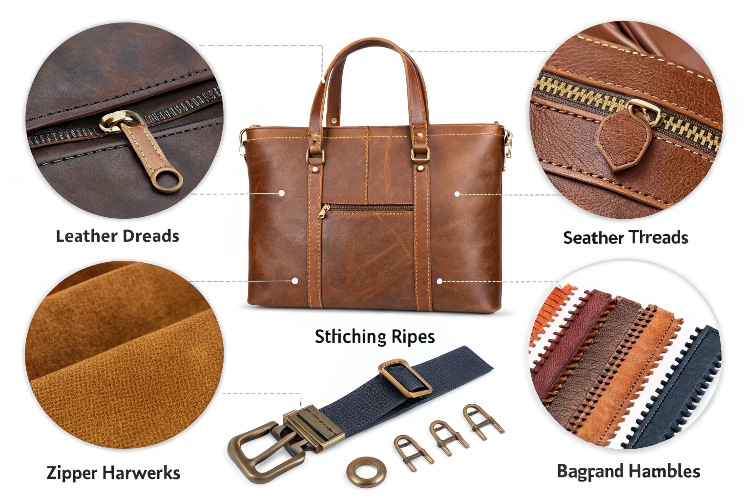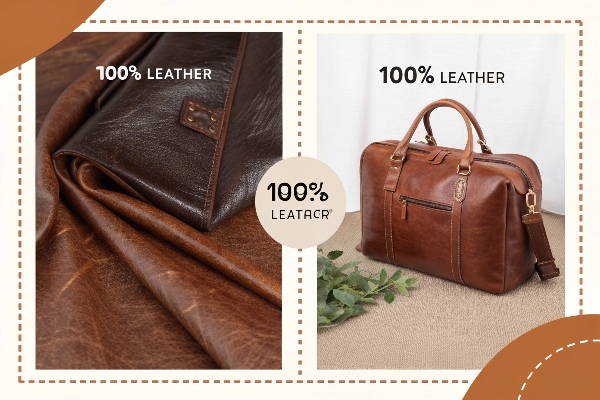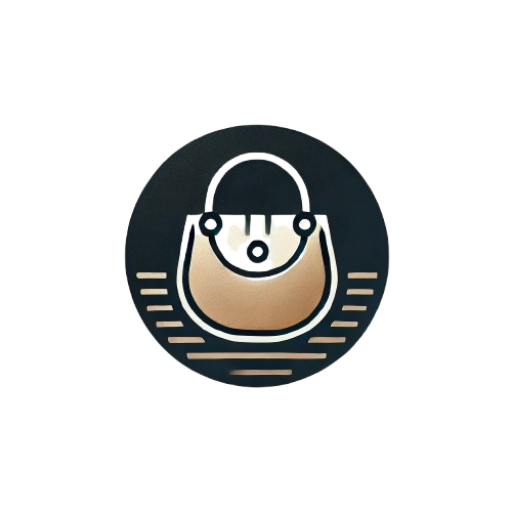- Texture & Pores – Real leather has uneven grains and visible pores (no repeating patterns).
- Smell – Genuine leather emits a natural, earthy scent (synthetics smell chemical or plastic-like).
- Edge Inspection – Real leather edges are slightly rough; faux leather has perfectly smooth, coated edges.
- Burn Test (caution!) – Real leather chars like burnt hair; fake leather melts and smells like plastic.
- Water Absorption – Real leather absorbs droplets in 10-20 sec; synthetics repel or absorb slower (>30 sec).
Key Data: High-end leather bags often cost >$200+ and label “full-grain” or “top-grain.”
Chapter 1: Sensory Testing Methods (Touch, Smell, Burn Test)
1. Touch Sensation: Don’t rely solely on eyes – hands are more reliable than eyes
Real leather feels like human skin with temperature changes. It might feel cool initially but warms up after a few seconds. Fake leather (like PVC or PU) usually stays cold or feels sticky. Press the surface with your finger: real leather shows fine wrinkles that slowly recover, while synthetic leather either shows no change or snaps back mechanically.
Check edge cuts. Real leather resembles layer cake – cross-sections show fiber layers (like meat fibers), while fake leather has neat cuts and may expose mesh fabric backing. Overseas leather repair experts often use this method. YouTube creator Leathercraft Studio has demonstrated comparative examples.
2. Smell: Your nose beats detectors
Real leather has a blend of smoky, woody, and slight animal fat aroma, similar to high-end shoe store smells. Note: Newly manufactured real leather might have chemical coating odors – let it air for 2-3 days before testing. Fake leather either has no smell or emits sharp plastic/glue odors.
Cool fact: Vegetable-tanned real leather (like Tuscan-made Italian leather) carries subtle tree bark fragrance, while chemically-tanned versions smell stronger. If sellers claim it’s “new fragrance leather” – run!
3. Burn Test: For the brave
Warning: First test on interior labels or extra material! Never burn the actual product!
Use a lighter on edges: Real leather curls like burning hair, emits white smoke, and leaves crumbly ash. Fake leather produces black smoke, drips plastic-like mucus that hardens when cooled. The Leather Industries of America (LIA) 2021 experiment found nitrogen residues (from animal protein) in real leather ashes, while synthetic leather showed polyethylene.
Caution: Some high-end fake leathers use protein coatings that mimic burning hair smell. Combine with other methods like price checking (real leather bags rarely cost below $200) and seller credentials.
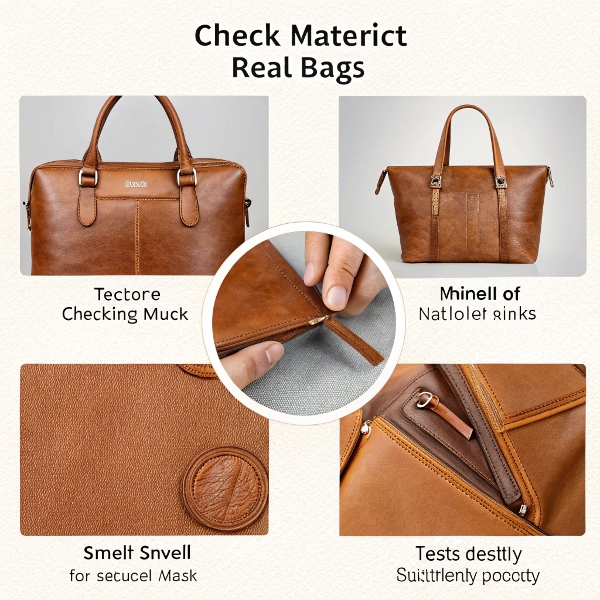
Labels vs. Authenticity Identification (Meaning of “Full Grain” and “Top Grain”)
Don’t Be Fooled by Labels – Check These Terms First
If a label only says “Genuine Leather”, don’t celebrate yet. This term is as vague as saying “this is food” in Western markets – it could mean real leather or compressed recycled leather scraps. Focus on finding bags specifically marked “Full Grain” or “Top Grain“. These are the real “ID cards” for genuine leather.
Full Grain: Raw Luxury
Full Grain leather is the untouched boss of leather, keeping its natural texture and pores without surface grinding. The bumps you feel, even small scars, are real. This type develops more shine with use, commonly seen in $2000+ handmade bags or premium shoes (like Red Wing’s classic work boots). Warning: Some sellers use “100% Leather” to fake full grain. Directly ask customer service “Is this full-grain untreated?” to confirm.
Top Grain: Refined But Less Durable
Top Grain sounds premium but is actually second-tier polished leather. The surface coating (like pebble texture) hides natural flaws. Benefits include smoother feel, but cracked coating can’t be fixed. Brands like Coach and Michael Kors often use this for mid-range lines. Check stitching areas for coating peeling before buying.
Certification Labels Beat Marketing Hype
Common Western leather certifications:
1. Certified Leather (with calfskin icon): European Leather Association standard requiring ≥60% natural fiber content
2. Pelle Conciata al Vegetale (Italian vegetable-tanned mark): Full plant tanning + no heavy metals, used by Italian heritage brands like The Bridge
These marks guarantee it’s not plastic. But don’t blindly trust “Made in Italy” – leather produced in Bangladesh can still get Italian certification.
Avoid Wordplay Traps
If labels say:
– “Bonded Leather” = glued leather scraps
– “PU Leather” = pure plastic
– “Bi-cast Leather” = fake leather with real leather edges
Walk away immediately. Pro trick: Press firmly with your fingernail for 5 seconds in a hidden area (like strap underside). Real leather shows temporary indentation, PU leather springs back instantly.
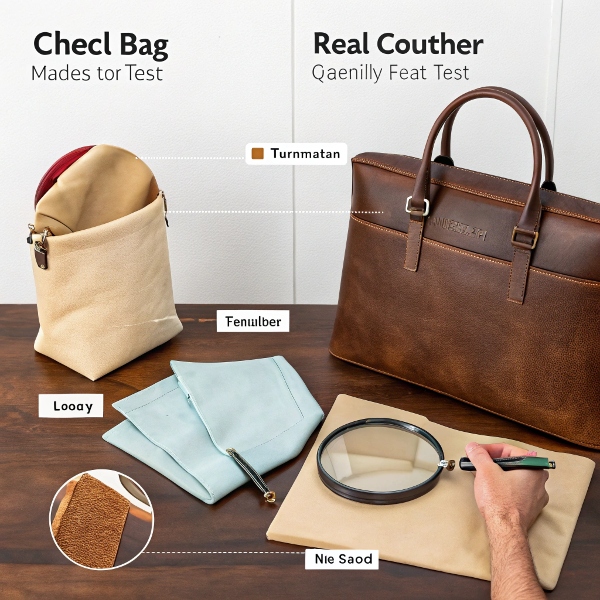
Professional Tool Assistance (Microscopic Observation of Fiber Structure)
Why can microscopes distinguish real from fake?
Genuine leather’s fiber structure is as unique as human fingerprints. When observing under a professional microscope at 400x magnification or higher, you will see a natural three-dimensional network structure. Collagen fibers interlace like tree branches, with no repeating patterns. Synthetic leather (e.g., PU/PVC) either shows uniform grid patterns or reveals obvious plastic substrates in the base layer.
How to operate specifically?
Find an inconspicuous scrap (never cut visible parts of the bag). Use tweezers to tear out a few fibers. When adjusting the microscope to 100-400x magnification, focus on three points:
1. Genuine leather fiber edges show fuzzy serrations, like torn cotton
2. Cross-sections reveal color layers of varying depths (caused by natural pores and uneven oil distribution)
3. Synthetic material fibers either appear as smooth plastic strips or show repetitive woven patterns
Tips from international experts
John Carter, a certified appraiser from the American Leather Association, shared practical techniques: Scratch the sample with a fingernail before observation. Genuine leather fibers will stand up and become fuzzy after scraping, while synthetic materials either remain unchanged or break directly. He also recommends rotating the sample during observation – genuine leather shows matte to glossy gradient sheen from different angles, characteristic of natural oil layers.
Beware of high-quality imitations
Recent European markets have seen “reconstituted leather” made from compressed genuine leather scraps, which also shows natural fibers under microscopy. Check fiber density – genuine leather has about 150-300 randomly arranged fibers per square millimeter, while reconstituted leather shows sudden density changes with abnormally tight clustering in certain areas.
DIY methods at home
Without professional equipment, combine a smartphone macro lens with a magnifying glass for emergency checks. Focus on fiber ends – genuine leather fracture surfaces resemble uneven tree roots, while synthetic materials show smooth cuts. A clever trick: Use transparent tape to collect fibers and observe against light. Genuine leather fibers curl slightly, while synthetic fibers stay straight.
Common Counterfeit Techniques Exposed
Embossed Patterns: Turning Plastic into “Genuine Leather”
I witnessed in New York’s leather market that using high-temperature embossing on synthetic materials to create lychee patterns is the most common scam. These embossing machines work like giant irons, pressing artificial textures resembling natural leather onto PVC or PU materials. A simple test: scratch the edge firmly with a nail ten times. Real leather will show fine wrinkles, while fake leather will turn white or shed coating.
Little-known fact: Genuine cowhide has irregular pore arrangements, like human fingerprints without repeating patterns. Embossed fake leather repeats patterns every 20 centimeters. Measure with a ruler for obvious repetition. Last year, Consumer Reports exposed a contemporary luxury brand using this technique.
Coating Deception: The 1mm Lie
A Milan leather craftsman taught me that thick coatings now hide low-quality leather. These coatings work like wall paint, reaching 1mm thickness. Test with medical alcohol: real leather absorbs quickly and darkens, while coated leather resists absorption for 30 minutes. Always test on inner straps to avoid surface stains.
A sneakier trick uses split leather + coating. This material mixes genuine leather scraps with binders. Though containing leather components, it has poor durability and breathability. Pro tip: Peel coating from stitched areas. Real leather reveals fuzzy fibers, while fake materials show neat mesh fabric.
Las Vegas customs found 83% of seized counterfeits used these methods. Remember: Real leather smells natural and earthy, like raw steak. Chemically coated bags smell like plastic or strong fragrance. Next shopping trip, scratch hidden areas with a coin. Real leather leaves erasable marks, while fake leather peels immediately.
